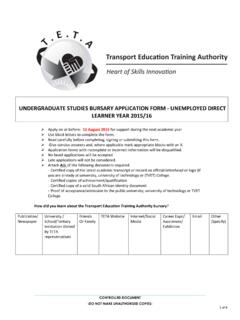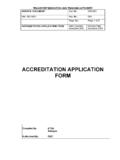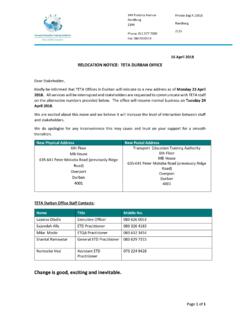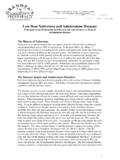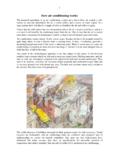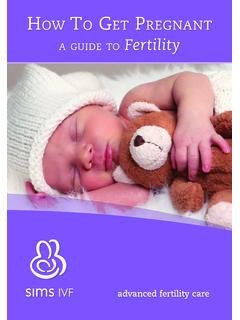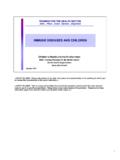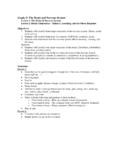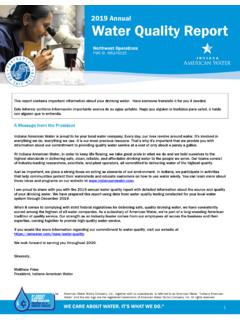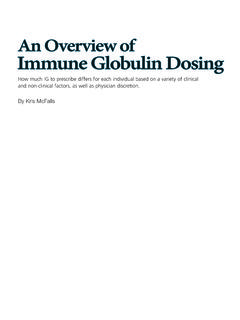Transcription of RPL integrated Health and Safety in the workplace …
1 Assessment guide for Health and Safety in the workplace Page 1 of 23 ASSESSMENT GUIDE OF ASSESSMENTS FOR Health & Safety IN THE workplace ecognition of Prior Learning (RPL) Assessment guide for Health and Safety in the workplace Page 2 of 23 National Certificate in Professional Driving Qualification ID: 50285 NQF Level 3 Assessment Guide for RPL Health & Safety in the workplace Assessment guide for Health and Safety in the workplace Page 3 of 23 UNIT STANDARDS IN THIS VOLUME Unit Standard Number Unit Standard Title NQF Level Credit Value 114941 Apply knowledge of HIV/AIDS to a specific business sector and a workplace 3 4 8016 Maintaining occupational Health , Safety and general housekeeping 3 8 116534 Carry out basic first aid treatment in the workplace 3 2 Assessment guide for Health and Safety in the workplace Page 4 of 23 TABLE OF CONTENTS Description Page Number Unit Standard 1 of this Volume Specific outcome 1 answers and competency criteria 5 - 7 Specific outcome 2 answers and competency criteria 8 - 9 Specific outcome 3 answers and competency criteria 10 Specific outcome 4 answers and competency criteria 11 12 Specific outcome 5 answers and competency criteria 13 Unit Standard 2 of this Volume Specific outcome 1 answers and competency criteria 14 16 Specific outcome 2 answers and competency criteria 17 18 Specific outcome 3 answers and competency criteria 19 20 Unit Standard 2 of this Volume Recommend Training (see comments)
2 21 23 Assessment guide for Health and Safety in the workplace Page 5 of 23 Unit Standard 1 of this Volume Answers for Evidence Guide Unit Standard ID Title Apply knowledge of HIV/AIDS to a specific business sector and a workplace Unit Standard number: 114941 Specific outcome 1: Explain HIV and Aids. Assessment Criteria: 1. The concepts HIV and AIDS are known and explained at a basic level of understanding. 2. The way in which the immune system works is explained with reference to the role of antibodies and how HIV attacks the immune system. 3. The concept of a window period is explained and an indication is given of how this affects the accuracy of test results. 4. The impact of opportunistic infections on the compromised immune system is explained with examples. 5. The stages of the disease are outlined with an example of what happens at each stage from infection with HIV to full-blown AIDS and death. 6. The ways in which HIV is transmitted are discussed with examples.
3 Written Knowledge Test Question 1 (1) Define HIV/AIDS. HIV is a virus. Viruses infect the cells that make up the human body and replicate (make new copies of themselves) within those cells. A virus can also damage human cells, which is one of the things that can make a person ill. Question 2 (2) Explain the basic concept of HIV/AIDS. HIV stands for the 'Human Immunodeficiency Virus'. Someone who is diagnosed as infected with HIV is said to be 'HIV+' or 'HIV positive' Question 3 (2) Explain how someone can be infected by HIV/AIDS. HIV can be passed from one person to another. Someone can become infected with HIV through contact with the bodily fluids of someone who already has HIV. Question 4 (3) Explain the function of the immune system. The job of your immune system is to protect your body from these infections. The immune system protects you in three different ways: o It creates a barrier that prevents bacteria and viruses from entering your body.
4 O If a bacteria or virus does get into the body, the immune system tries to detect and eliminate it before it can make itself at home and reproduce. o If the virus or bacteria is able to reproduce and start causing problems, your immune system is in charge of eliminating it. Question 5 (2) Discuss the effect on antibodies when a person is infected by HIV/AIDS. o AIDS is caused by a virus called HIV, the Human Immunodeficiency Virus. If you are infected with HIV, your body will try to fight the infection. It will make "antibodies" -- special molecules to fight HIV. o A blood test for HIV looks for these antibodies. If you have them in your blood, it means that you have HIV infection. Question 6 (3) Discuss how HIV/AIDS attack the immune system. o The immune system also has several other important jobs. For example, your immune system can detect cancer in early stages and eliminate it in many cases. o When a virus or bacteria (also known generically as a germ) invade your body and reproduces, it normally causes problems.
5 Generally, the germ's presence produces some side effect that makes you sick. For Assessment guide for Health and Safety in the workplace Page 6 of 23 example, the strep throat bacteria (Streptococcus) releases a toxin that causes inflammation in your throat. The poliovirus releases toxins that destroy nerve cells (often leading to paralysis). o Some bacteria are benign or beneficial (for example, we all have millions of bacteria in our intestines and they help digest food), but many are harmful once they get into the body or the bloodstream. Question 7 (1) Define the concept window period. The window period is the period between the onset of HIV infection and the appearance of detectable antibodies to the virus. Question 8 (2) Discuss the concept window period. The window period is very significant in relation to the timing of HIV tests. Persons who are tested during the window period may receive a negative HIV test result although they may be infected with HIV.
6 Persons disclosing HIV-related risk factors in the 14 weeks before testing negative for HIV are encouraged to be retested at the end of the window period. Question 9 (2) Explain how the window period affects the accuracy of the test results. o Any antibody-based blood tests (such as the ELISA, rapid tests and the Western Blot) conducted during this window period may give false negative results. o Antibodies are produced from about three weeks after infection and usually become detectable by four to six weeks after infection. This four- to six-week period between infection and a positive test is called the window period. Question 10 (1) Define opportunistic infections. An opportunistic infection is an infection that would not normally make a healthy person sick, but will often make a person with a weakened immune system sick. The infection takes advantage of the opportunity offered by a compromised immune system Question 11 (4) Name four opportunistic infections. o Tuberculosis o Kaposi s sarcoma o Cytomegalovirus (CMV) o Toxoplasmosis Question 12 (10) Name and discuss the stages of the disease with an example of what happens at each stage.
7 Stage 1 - The primary HIV infection phase (or acute sero-conversion illness) Primary HIV infection is the first stage of HIV disease, typically lasting only a week, or two, when the virus first establishes itself in the body. Some researchers use the term acute HIV infection to describe the period of time between when a person is first infected with HIV and when antibodies (proteins made by the immune system in response to infection) against the virus are produced by the body (usually 6 to 12 weeks) and can be detected by an HIV test. Stage 2 - The asymptomatic latent phase After the acute stage of HIV infection, people infected with HIV continue to look and feel completely well for long periods, usually for many years. During this time, the only indication that you are infected with HIV is that you will test positive on standard (antibody) HIV tests and you may have swollen lymph glands. Stage 3 - The minor symptomatic phase Show minor and early symptoms through HIV disease through fevers, skin rashes, infections, weigh loss, chronic diarrhea etc.
8 Assessment guide for Health and Safety in the workplace Page 7 of 23 Stage 4 - The major symptomatic phase and opportunistic diseases Begin to appear when the immune system deteriorates. The person is usually bedridden for at least 50% of the day. Stage 5 - AIDS-defining conditions: the severe symptomatic phase genera lly known as full-blown Aids Patients do not respond to antibiotic treatments and more persistent untreatable opportunistic conditions and cancer manifest. People with full-blown Aids normally die within two years. Prevention may prolong the person s life. Question 13 (2) Outline the relationship between human behaviour and HIV/AIDS. People living with HIV/AIDS are normally seen as an outcast because society are not educated enough to understand that they will not be infected by HIV/AIDS through hugs, handshakes etc. There is a stigma. Someone living with HIV/AIDS must act in a responsible way and realize that he/she may put his/her fellow employees or other people at risk.
9 Question 14 (2) Explain how the individual with HIV/AIDS can avoid spreading HIV/AIDS to reduce the risk of infection. HIV is spread most often through unprotected sex with an infected partner. The virus can enter the body through the lining of the vagina, vulva, penis, rectum, or mouth during sex. Avoid risky behavior. HIV can infect anyone who practices risky behaviors such as Sharing drug needles or syringes Having sexual contact, including oral sexual contact, with an infected person without using a condom Having sexual contact with someone whose HIV status is unknown Question 15 (1) Explain how to create a caring environment in an organization for workers who has HIV/AIDS Allocate 1 mark if the learner shows an understanding in his/her own words. Question 16 (1) Explain how HIV/AIDS are transmitted. HIV is transmitted through unprotected sexual intercourse with an infected partner. HIV can also be transmitted through infected blood or blood products, such as blood transfusions, or by the sharing of contaminated needles.
10 Question 17 (1) Discuss the importance of organizing ones personal life style. Allocate 1 mark if the learner shows an understanding in his/her own words. Total: 40 Assessment based on Competency: The learner must obtain at least 20/40 to be competent. Assessment guide for Health and Safety in the workplace Page 8 of 23 Answers for Evidence Guide Specific outcome 2: Describe what behaviour is safe and what behaviour carries the risk of HIV transmission. Assessment Criteria: 1. The chances of a person surviving with AIDS are discussed with reference to the latest views on wellbeing of an HIV positive person. 2. The relationship between human behaviour and HIV/AIDS is outlined and ways in which the individual can avoid contracting or spreading HIV/AIDS are indicated with reference to reducing the risk of infection. 3. Examples of behaviour that carry a risk of contracting HIV/AIDS are named and classified according to whether they carry a high, medium or low risk.
